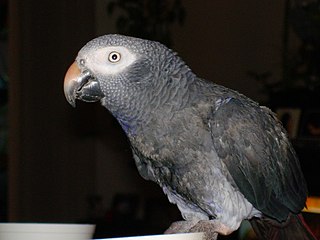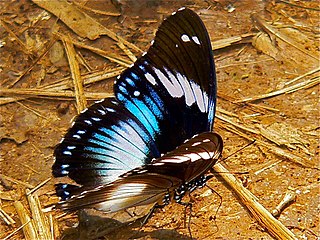
São Tomé and Príncipe is a small nation composed of an archipelago located in the Gulf of Guinea of the equatorial Atlantic Ocean. The nation's main islands are São Tomé Island and Príncipe Island, for which the country is named. These are located about 300 and 250 kilometres, respectively, off the northwest coast of Gabon in Central Africa. The nation's geographic coordinates are a latitude of 1°00′N and a longitude of 7°00′E.

The house wren is a very small songbird of the wren family, Troglodytidae. It occurs from Canada to southernmost South America, and is thus the most widely distributed native bird in the Americas. It occurs in most suburban areas in its range and it is the single most common wren. Its taxonomy is highly complex and some subspecies groups are often considered separate species. The name troglodytes means "hole dweller", and is a reference to bird's tendency to disappear into crevices when hunting insects or to seek shelter.

São Tomé Island, at 854 km2 (330 sq mi), is the largest island of São Tomé and Príncipe and is home in May 2018 to about 193,380 or 96% of the nation's population. The island is divided into six districts. It is located 2 km north of the equator.

The São Tomé shrew is a white-toothed shrew about 3.0 in (7.6 cm) long found only on São Tomé Island, São Tomé and Príncipe. It is listed as a critically endangered species due to habitat loss and a restricted range. It was discovered in 1886. The population continues to decrease, making these animals rare. It is found only on São Tomé Island, a small island that is actually a shield volcano that rises out of the Atlantic Ocean.

The São Tomé, Príncipe, and Annobón forests, also known as the São Tomé, Príncipe, and Annobón moist lowland forests, is a tropical moist broadleaf forest ecoregion that covers the islands of São Tomé and Príncipe, which form the island nation of São Tomé and Príncipe, as well as the island of Annobón, which is part of Equatorial Guinea.

The São Tomé fiscal, or Newton's fiscal, is a species of bird in the family Laniidae. It is endemic to São Tomé Island, São Tomé and Príncipe. It is 20 to 21 centimeters long. The bird is black above with a white shoulder-scapular bar. The São Tomé fiscal has a pale yellow chin, breast, belly, flanks vent and under tail. Its graduated tail has all black central tail feathers and an increasing amount of white on outer web from inner to outer tail feathers. The Lanius newtoni has a clear voice with a whistle tiuh tiuh often repeated and metallic tsink tsink audible over a long distance.

The São Tomé weaver is a species of bird in the family Ploceidae. It is endemic to São Tomé and Príncipe. They are found in the island of São Tomé. Its natural habitats are subtropical or tropical moist lowland forests and subtropical or tropical moist montane forests.

The São Tomé paradise flycatcher, also known as São Tomé flycatcher, is a species of bird in the family Monarchidae. The species was described by Thomas Richard Heywood Thomson in 1842. It is endemic to São Tomé Island. Its natural habitats are subtropical or tropical dry forests and subtropical or tropical moist lowland forests.

The wildlife of São Tomé and Príncipe is composed of its flora and fauna. São Tomé and Príncipe are oceanic islands which have always been separate from mainland West Africa and so there is a relatively low diversity of species, restricted to those that have managed to cross the sea to the islands. However the level of endemism is high with many species occurring nowhere else in the world.
The São Tomé free-tailed bat is a species of bat in the family Molossidae. It is endemic to São Tomé and Príncipe. Its natural habitats are dry savanna, moist savanna, and plantations. It is threatened by habitat loss. Only three individuals have ever been documented.

The São Tomé collared fruit bat is a species of megabat in the family Pteropodidae. It is endemic to São Tomé and Príncipe. Its natural habitats are subtropical or tropical moist lowland forest and subtropical or tropical moist montane forest. It is threatened by habitat destruction. This bat is unique in that it is the only known mammal where the whole population has an asymmetrical dental formula.

São Tomé and Príncipe, officially the Democratic Republic of São Tomé and Príncipe, is an island country in the Gulf of Guinea, off the western equatorial coast of Central Africa. It consists of two archipelagos around the two main islands of São Tomé and Príncipe, about 150 km (93.21 mi) apart and about 250 and 225 km off the north-western coast of Gabon. With a population of 201,800, São Tomé and Príncipe is the second-smallest and second-least populous African sovereign state after Seychelles.

Junonia terea, the soldier pansy or soldier commodore, is a butterfly of the family Nymphalidae. The species was first described by Dru Drury in 1773. It is found in the Afrotropical realm.

The Obô Natural Park of São Tomé is a natural park of São Tomé and Príncipe, covering 195 km2 (75 sq mi) of the island of São Tomé. It was established in 2006. It has not yet been assigned to an IUCN protected area category. It covers parts of the districts of Caué, Lemba, Lobata and Mé-Zóchi.

Xylotrechus a genus of longhorned beetles of the family Cerambycidae, containing some 200 described species.

Hypolimnas salmacis, the blue diadem, is a butterfly in the family Nymphalidae. It is found in Sierra Leone, Liberia, Ivory Coast, Ghana, Togo, Benin, Nigeria, Cameroon, Gabon, the Republic of the Congo, Angola, Equatorial Guinea, São Tomé and Príncipe, the DRC, Uganda, Sudan, Ethiopia, Kenya and Tanzania. The habitat consists of secondary forests and disturbed environments.
Insulochamus thomensis is a species of beetle in the family Cerambycidae. It was described by Karl Jordan in 1903 as Monochamus thomensis. It is known from São Tomé and Príncipe.

Phrynetopsis thomensis is a species of beetle in the family Cerambycidae. It was described by Karl Jordan in 1903. It is known from São Tomé and Príncipe.















